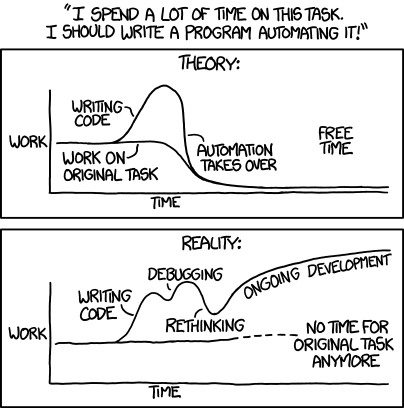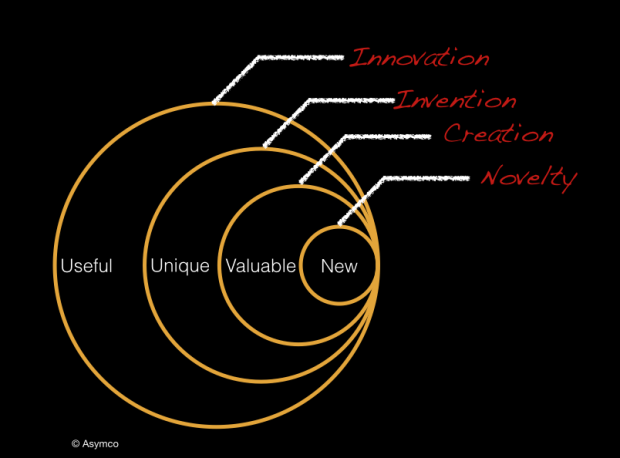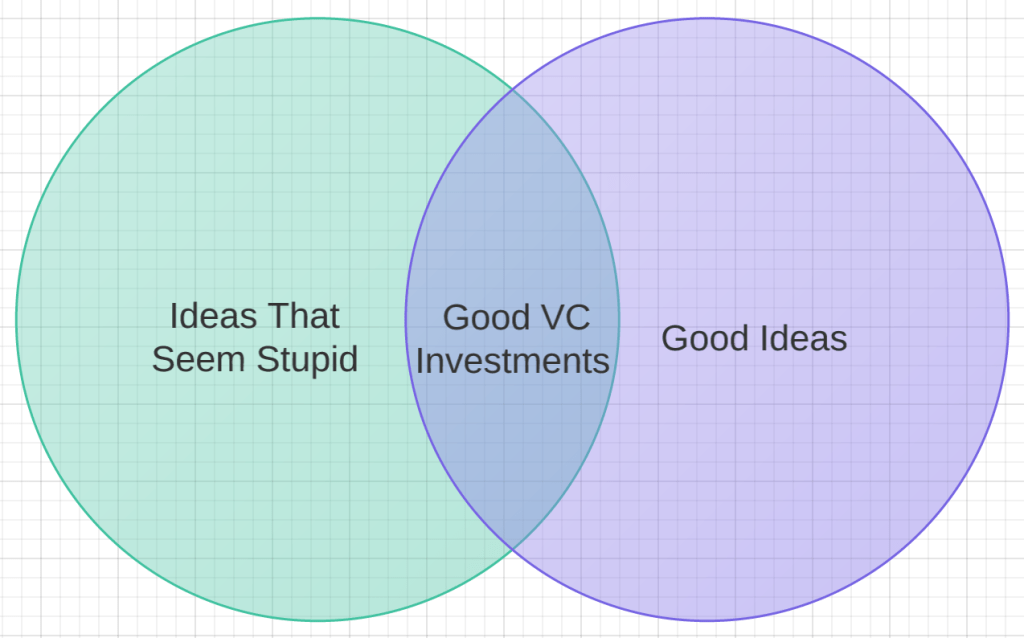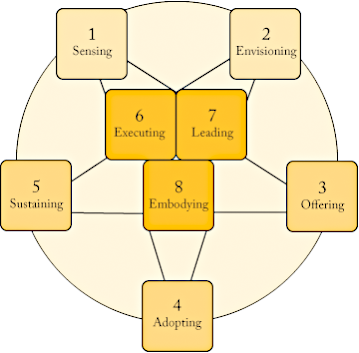Innovation is about finding a better way of doing something. Like many of the new development buzzwords (which many of them are over-used on many business documents), the concept of innovation originates from the world of business. It refers to the generation of new products through the process of creative entrepreneurship, putting it into production, and diffusing it more widely through increased sales. Innovation can be viewed as t he application of better solutions that meet new requirements, in-articulated needs, or existing market needs. This is accomplished through more effective products, processes, services, technologies, or ideas that are readily available to markets, governments and society. The term innovation can be defined as something original and, as a consequence, new, that “breaks into” the market or society.
Innoveracy: Misunderstanding Innovation article points out that there is a form of ignorance which seems to be universal: the inability to understand the concept and role of innovation. The way this is exhibited is in the misuse of the term and the inability to discern the difference between novelty, creation, invention and innovation. The result is a failure to understand the causes of success and failure in business and hence the conditions that lead to economic growth. The definition of innovation is easy to find but it seems to be hard to understand. Here is a simple taxonomy of related activities that put innovation in context:
- Novelty: Something new
- Creation: Something new and valuable
- Invention: Something new, having potential value through utility
- Innovation: Something new and uniquely useful
The taxonomy is illustrated with the following diagram.
The differences are also evident in the mechanisms that exist to protect the works: Novelties are usually not protectable, Creations are protected by copyright or trademark, Inventions can be protected for a limited time through patents (or kept secret) and Innovations can be protected through market competition but are not defensible through legal means.
Innovation is a lot of talked about nowdays as essential to businesses to do. Is innovation essential for development work? article tells that innovation has become central to the way development organisations go about their work. In November 2011, Bill Gates told the G20 that innovation was the key to development. Donors increasingly stress innovation as a key condition for funding, and many civil society organisations emphasise that innovation is central to the work they do.
Some innovation ideas are pretty simple, and some are much more complicated and even sound crazy when heard first. The is place for crazy sounding ideas: venture capitalists are gravely concerned that the tech startups they’re investing in just aren’t crazy enough:
Not all development problems require new solutions, sometimes you just need to use old things in a slightly new way. Development innovations may involve devising technology (such as a nanotech water treatment kit), creating a new approach (such as microfinance), finding a better way of delivering public services (such as one-stop egovernment service centres), identifying ways of working with communities (such as participation), or generating a management technique (such as organisation learning).
Theorists of innovation identify innovation itself as a brief moment of creativity, to be followed by the main routine work of producing and selling the innovation. When it comes to development, things are more complicated. Innovation needs to be viewed as tool, not master. Innovation is a process, not a one time event. Genuine innovation is valuable but rare.
There are many views on the innovation and innvation process. I try to collect together there some views I have found on-line. Hopefully they help you more than confuze. Managing complexity and reducing risk article has this drawing which I think pretty well describes innovation as done in product development:
8 essential practices of successful innovation from The Innovator’s Way shows essential practices in innovation process. Those practices are all integrated into a non-sequential, coherent whole and style in the person of the innovator.
In the IT work there is lots of work where a little thinking can be a source of innovation. Automating IT processes can be a huge time saver or it can fail depending on situation. XKCD comic strip Automation as illustrates this:

System integration is a critical element in project design article has an interesting project cost influence graphic. The recommendation is to involve a system integrator early in project design to help ensure high-quality projects that satisfy project requirements. Of course this article tries to market system integration services, but has also valid points to consider.
Core Contributor Loop (CTTDC) from Art Journal blog posting Blog Is The New Black tries to link inventing an idea to theory of entrepreneurship. It is essential to tune the engine by making improvements in product, marketing, code, design and operations.






5,690 Comments
Tomi Engdahl says:
https://polarnightenergy.fi/sand-battery
Tomi Engdahl says:
Tiny Laser Opens Door to Chip-Size Sensors The new frequency comb could make powerful sensors fit in a phone
https://spectrum.ieee.org/frequency-comb-2667465105
Tomi Engdahl says:
This NVIDIA Jetson-Powered “Invisible Drone” Disappears From Radar in a Flash
Future work could allow the drone to disguise itself as rabbits, dolphins, and more, a research team claims.
https://www.hackster.io/news/this-nvidia-jetson-powered-invisible-drone-disappears-from-radar-in-a-flash-704510eeea46
Tomi Engdahl says:
NEW TECHNIQUE TO EXTRACT GOLD FROM OLD ELECTRONICS COULD MAKE A FORTUNE, SCIENTISTS SAY
byVICTOR TANGERMANN
MAR 4, 5:00 PM EST
ETH ZURICH / ALAN KOVACEVIC
THEY USED A BYPRODUCT FROM THE CHEESEMAKING PROCESS TO TURN E-WASTE INTO GOLD.
https://futurism.com/the-byte/extract-gold-old-electronics-fortune
Tomi Engdahl says:
Researchers find exception to 200-year-old scientific law governing heat transfer
https://phys.org/news/2024-03-exception-year-scientific-law.html#google_vignette
Tomi Engdahl says:
There’s a Surprisingly Simple Way to Remove Microplastics From Your Drinking Water
https://www.sciencealert.com/theres-a-surprisingly-simple-way-to-remove-microplastics-from-your-drinking-water
A team from Guangzhou Medical University and Jinan University in China ran tests on both soft water and hard tap water (which is richer in minerals), adding in nanoplastics and microplastics (NMPs) before boiling the liquid and then filtering out any precipitates.
In some cases, up to 90 percent of the NMPs were removed by the boiling and filtering process, though the effectiveness varied based on the type of water. Of course the big benefit is that most people can do it using what they already have in their kitchen.
Tomi Engdahl says:
Plastic Found Inside More Than 50% of Plaques From Clogged Arteries
https://www.sciencealert.com/plastic-found-inside-more-than-50-of-plaques-from-clogged-arteries
Plastics are now everywhere, with tiny fragments found in several major organs of the human body, including the placenta.
Given how easily the microscopic particles infiltrate our tissues, it’s vital that we learn exactly what kinds of risks they could pose to our health.
Tomi Engdahl says:
Researchers reveal DVD-like disc that stores up to 200 terabytes
Researchers from China have succeeded in developing a new type of disc with a storage capacity of 200 terabytes, the size of a DVD.
https://www.pcworld.com/article/2254577/dvd-size-200-terabytes-of-data-capacity-on-new-optical-disc.html
Tomi Engdahl says:
Scientists Finally Discovered a New “Magical” Magnet
https://www.electricaltechnology.org/2024/03/scientists-discovered-new-magical-magnet.html#google_vignette
Discovery of the ‘Magical’ Magnet, Previously Believed to be Impossible – Scientific Research
Scientists have finally proven the existence of a new type of magnet, which was previously believed to be impossible. The team that discovered this magnet suggests that it could be used to create more efficient electronic devices. This new state of magnetism is called “alter magnetism.”
In the fridge magnets found in kitchens, after ferromagnets and antiferromagnets, alter magnetism forms the third branch of magnetism. Ferromagnets and antiferromagnets were first identified in the 1930s by French physicist Louis Néel.
Tomi Engdahl says:
https://www.tweaktown.com/news/96815/scientists-unveil-pc-breakthrough-that-gives-2x-speed-without-hardware-upgrades/index.html
Tomi Engdahl says:
https://hackaday.com/2024/03/25/the-cryotron-remembered/
Tomi Engdahl says:
https://hackaday.com/2024/03/24/retrotechtacular-right-to-repair-1987/
Tomi Engdahl says:
https://hackaday.com/2024/03/24/concrete-clears-its-own-snow/
Tomi Engdahl says:
Aston University boosts internet speed, revolutionizing downloads and streaming: https://ie.social/VwMjQ
Tomi Engdahl says:
Explosive chemistry – with Andrew Szydlo
https://youtu.be/uswf_8Ch39s?si=FOgq1xoLhLu8bo2Y
Tomi Engdahl says:
Weak waste removal in the brain linked to Alzheimer’s
A combination of advances in magnetic resonance imaging to help track the movement of fluids in the brain and supercomputer-powered simulations are modifying our understanding of cognitive decline.
https://www.nature.com/articles/d42473-023-00446-5?utm_source=facebook&utm_medium=social&utm_campaign=APSR_FOCAL_AWA1_GL_PCFU_CFULF_JTD_RD-AP24&fbclid=IwAR3w69nAq88T4z4ZvYOo5AIR7HyZ63cVf1XAHC-VKey7H-KWDlQPapW9Q68_aem_AWfxaV2sT_hZ9BdDYT9yXtUMDYnGjjS0Bxg7rcbva_wh9AtUUmOjB7d5j0CqowkEt_tPlKZw5Wzo5jtIvYCu39y5&utm_id=120205645612170572&utm_content=120205646873980572&utm_term=120205646873990572
Tomi Engdahl says:
https://hackaday.com/2024/03/26/reprogrammable-transistors/
Tomi Engdahl says:
Playboy image from 1972 gets ban from IEEE computer journals
Use of “Lenna” image in computer image processing research stretches back to the 1970s.
https://arstechnica.com/information-technology/2024/03/playboy-image-from-1972-gets-ban-from-ieee-computer-journals/
On Wednesday, the IEEE Computer Society announced to members that, after April 1, it would no longer accept papers that include a frequently used image of a 1972 Playboy model named Lena Forsén. The so-called “Lenna image,” (Forsén added an extra “n” to her name in her Playboy appearance to aid pronunciation) has been used in image processing research since 1973 and has attracted criticism for making some women feel unwelcome in the field.
In an email from the IEEE Computer Society sent to members on Wednesday, Technical & Conference Activities Vice President Terry Benzel wrote, “IEEE’s diversity statement and supporting policies such as the IEEE Code of Ethics speak to IEEE’s commitment to promoting an including and equitable culture that welcomes all. In alignment with this culture and with respect to the wishes of the subject of the image, Lena Forsén, IEEE will no longer accept submitted papers which include the ‘Lena image.’”
An uncropped version of the 512×512-pixel test image originally appeared as the centerfold picture for the December 1972 issue of Playboy Magazine. Usage of the Lenna image in image processing began in June or July 1973 when an assistant professor named Alexander Sawchuck and a graduate student at the University of Southern California Signal and Image Processing Institute scanned a square portion of the centerfold image with a primitive drum scanner, omitting nudity present in the original image. They scanned it for a colleague’s conference paper, and after that, others began to use the image as well.
The image’s use spread in other papers throughout the 1970s, ’80s, and ’90s, and it caught Playboy’s attention, but the company decided to overlook the copyright violations. In 1997, Playboy helped track down Forsén, who appeared at the 50th Annual Conference of the Society for Imaging Science in Technology, signing autographs for fans. “They must be so tired of me… looking at the same picture for all these years!” she said at the time. VP of new media at Playboy Eileen Kent told Wired, “We decided we should exploit this, because it is a phenomenon.”
Tomi Engdahl says:
The comp.compression Usenet newsgroup FAQ document claims that in 1988, a Swedish publication asked Forsén if she minded her image being used in computer science, and she was reportedly pleasantly amused. In a 2019 Wired article, Linda Kinstler wrote that Forsén did not harbor resentment about the image, but she regretted that she wasn’t paid better for it originally. “I’m really proud of that picture,” she told Kinstler at the time.
Tomi Engdahl says:
Does green tea offer cognitive and sleep benefits?
A leading Japanese green tea and matcha company is focusing research efforts on tackling health challenges related to ageing
https://www.nature.com/articles/d42473-023-00394-0?utm_source=facebook&utm_medium=social&utm_campaign=CONR_NINDX_AWA1_GL_PCFU_CFULF_ITO-HS-AP24&fbclid=IwAR2CvJYdlrAZHVjc2Jub5_6mM1nb1h782p10jv7YBZmHjaDlsAPjjCBemyU_aem_AbmYKk6SOVv5aVEpCxJlZX8YR3mUcedj74xz3srYAvzlt6J9ZTHExksX3crlQf-UbzI1L35BxdARdsiDcyJc5iLk&utm_id=120205633739540572&utm_content=120205633739550572&utm_term=120205633739500572
Tomi Engdahl says:
Population tipping point could arrive by 2030
Study estimates global fertility will drop below replacement level years earlier than others predict
https://www.science.org/content/article/population-tipping-point-could-arrive-2030?fbclid=IwAR3-pNKT5qqKgeJYpxSCVARNDnA2gLDbWUC87IWxsbFUuZtRbihIZpbp8CA
Two point one: That’s how many children everyone able to give birth must have to keep the human population from beginning to fall. Demographers have long expected the world will dip below this magic number—known as the replacement level—in the coming decades. A new study published last month in The Lancet, however, puts the tipping point startlingly near: as soon as 2030.
It’s no surprise that fertility is dropping in many countries, which demographers attribute to factors such as higher education levels among people who give birth, rising incomes, and expanded access to contraceptives. The United States is at 1.6 instead of the requisite 2.1, for example, and China and Taiwan are hovering at about 1.2 and one, respectively.
A drop below replacement fertility does not mean global population will immediately fall. It will likely take about 30 additional years, or roughly how long it takes for a new generation to start to reproduce, for the global death rate to exceed the birth rate. Even then, because countries’ fertility may vary dramatically, global fertility rate is a “very abstract concept that doesn’t mean much,”
Estimating when the world will reach the turning point is challenging. The new model from IHME is based on how many children each population “cohort”—people born in a specific year—will give birth to over their lifetime.
Tomi Engdahl says:
Her lifetime of research on messenger RNA was widely viewed as a road to nowhere and led to her being demoted and struggling for research grants. However, her work came to fruition just as the world urgently needed new vaccines to tackle the COVID-19 pandemic.
Her perseverance has since been recognized by countless awards, most notably the 2023 Nobel Prize in Physiology or Medicine.
https://www.nature.com/articles/d42473-024-00048-9?utm_medium=paid_social&utm_source=facebook&utm_content=null&utm_term=null&utm_campaign=CONR_COLLE_AWA1_GL_PCFU_CFULF_UNISZEGED&fbclid=IwAR0J-qSw4ZcZ2S_5e_wi6NWK57Z1f9D8_XDr2T2g50A4qL-ARF5HOdQ6d7c_aem_AaKjTcgU7TcIVfUf5UmRwMFWJr0cLE_mCDhOi9JDiQv7NQN0SjRYjI2e_huvlptAsvW8adpyJ-SleDdq9Mor7cmj&utm_id=120205901373430572
Tomi Engdahl says:
‘This could be 100 times worse than Covid’: Bird flu warning from scientists who say HALF of infections with H5N1 in people are fatal – as White House says it’s ‘monitoring’ the situation
https://www.dailymail.co.uk/health/article-13268235/This-100-times-worse-Covid-Bird-flu-warning-scientists-say-HALF-infections-H5N1-people-fatal-White-House-says-monitoring-situation.html?ito=social-facebook&fbclid=IwAR3HLdq8jeVFE_i0adbu7y-lVM7zNBeGZK_0V47rkWBfg3Ti3cdey1hqZPU
Speaking at a briefing, virus researchers said the H5N1 strain of bird flu may now be getting ‘dangerously close’ to triggering a pandemic.
Multiple cases of the infection in a variety of mammals, including cows, cats and, more recently, humans, are all raising the risk of the virus mutating to become more transmissible, they said.
But others attending the briefing said it was too early to panic because there were still too many unknowns about recent cases to warrant sounding the alarm.
Tomi Engdahl says:
How DEC’s LANBridge 100 Gave Ethernet A Fighting Chance
https://hackaday.com/2024/04/09/how-decs-lanbridge-100-gave-ethernet-a-fighting-chance/
When Ethernet was originally envisioned, it would use a common, shared medium (the ‘Ether’ part), with transmitting and collision resolution handled by the carrier sense multiple access with collision detection (CSMA/CD) method. While effective and cheap, this limited Ethernet to a 1.5 km cable run and 10 Mb/s transfer rate. As [Alan Kirby] worked at Digital Equipment Corp. (DEC) in the 1980s and 1990s, he saw how competing network technologies including Fiber Distributed Data Interface (FDDI) – that DEC also worked on – threatened to extinguish Ethernet despite these alternatives being more expensive. The solution here would be store-and-forward switching, [Alan] figured.
After teaming up with Mark Kempf, both engineers managed to convince DEC management to give them a chance to develop such a switch for Ethernet, which turned into the LANBridge 100. As a so-called ‘learning bridge’, it operated on Layer 2 of the network stack, learning the MAC addresses of the connected systems and forwarding only those packets that were relevant for the other network. This instantly prevented collisions between thus connected networks, allowed for long (fiber) runs between bridges and would be the beginning of the transformation of Ethernet as a shared medium (like WiFi today) into a star topology network, with each connected system getting its very own Ethernet cable to a dedicated switch port.
How Engineers at Digital Equipment Corp. Saved Ethernet
Their groundbreaking learning bridge technology increased LAN performance
https://spectrum.ieee.org/how-dec-engineers-saved-ethernet
Tomi Engdahl says:
Don’t blame the lazy people, they never did anything.
Tomi Engdahl says:
Your Brain Breaks Its Own DNA to Form Memories That Can Last a Lifetime
https://singularityhub.com/2024/04/08/your-brain-breaks-its-own-dna-to-form-memories-that-can-last-a-lifetime/
Some memories last a lifetime. The awe of seeing a full solar eclipse. The first smile you shared with your partner. The glimpse of a beloved pet who just passed away in their sleep.
Other memories, not so much. Few of us remember what we had for lunch a week ago. Why do some memories last, while others fade away?
Surprisingly, the answer may be broken DNA and inflammation in the brain. On the surface, these processes sound utterly detrimental to brain function. Broken DNA strands are usually associated with cancer, and inflammation is linked to aging.
But a new study in mice suggests that breaking and repairing DNA in neurons paves the way for long-lasting memories
Tomi Engdahl says:
Japan demonstrates levitation without using any external power
Researchers are confident that their levitation technology can beat the best gravimeters developed till date.
https://interestingengineering.com/science/levitating-material-gravity-free-tech
Tomi Engdahl says:
Obituary: Peter Higgs (1929-2024) physicist who predicted boson that explains why particles have mass
Peter Higgs obituary: physicist who predicted boson that explains why particles have mass
Theoretical physicist saw his eponymous particle discovered after 48 years.
https://www.nature.com/articles/d41586-024-01103-7?utm_medium=Social&utm_campaign=nature&utm_source=Facebook&fbclid=IwAR332cyfMB4XDylqz3Od_R3EhWZEbu725dEVNB9FFEShFdI5K-DIpKgv3dU#Echobox=1712914926-1
During a few weeks in the summer of 1964, Peter Higgs, a theoretical physicist at the University of Edinburgh, UK, wrote two short papers outlining his ideas for a mechanism that could give mass to fundamental particles, the building blocks of the Universe. His aim was to rescue a theory that was mathematically appealing but ultimately unrealistic because the particles it described had no mass. The second paper drew attention to a measurable consequence of his proposal — it predicted the existence of a new massive particle. Nearly half a century later, the discovery of the predicted particle brought Higgs, who has died aged 94, a share of the 2013 Nobel Prize in Physics.
Tomi Engdahl says:
Menevätkö illat tällä kaavalla? Nämä 10 kysymystä voivat paljastaa, elätkö tavalla, joka väsyttää
Omat elämäntavat voivat väsyttää myös eri tavalla kuin äkkiseltään ajattelisi.
https://www.is.fi/hyvaolo/art-2000010346891.html
Tomi Engdahl says:
https://viralnewsflare.com/funny/spud-tacular-seating-a-unique-twist-on-home-comfort/
Tomi Engdahl says:
https://discovery.kaust.edu.sa/en/article/22919/simple-solution-for-frequency-space-invaders/
Tomi Engdahl says:
Just because it’s expensive and the case has a half inch thick aluminum faceplate doesn’t mean the circuits inside are competently designed. Lots of audiophile gear ranges from poor to bad in terms of design. (If they’ve even changed anything from the original manufacturer demo circuit designs as I recall one preamp that just took TI’s basic circuit suggestion from the white sheet and stuck it in a fancy case claiming to be something special.) Afterall, no negative feedback in amplifiers at all somehow became an audiophile standard.
Tomi Engdahl says:
https://hackaday.com/2024/04/15/remembering-peter-higgs-and-the-gravity-of-his-contributions-to-physics/
Tomi Engdahl says:
https://hackaday.com/2024/04/04/where-graph-theory-meets-the-road-the-algorithms-behind-route-planning/
Tomi Engdahl says:
https://uk.pcmag.com/networking/151644/scientists-hit-301000-gbps-internet-by-tapping-new-fiber-wavelength-bands
Tomi Engdahl says:
https://etn.fi/index.php/13-news/16107-tulevaisuuden-litiumakku-voi-sitoa-hiilidioksidia
Tomi Engdahl says:
5 tärkeää keinoa pitää pää terävänä ikääntyessä – tämä on yksi tärkeimmistä
Jokainen voi vaikuttaa siihen, että aivot pysyvät mahdollisimman hyvässä terässä.
https://www.is.fi/terveys/art-2000010258513.html
Tomi Engdahl says:
Breakthrough CO2-fueled generator turns greenhouse gas into electricity
Researchers claim that they were able to capture approximately 1 percent of the inherent energy contained within CO2 gas.
https://interestingengineering.com/energy/generator-turns-greenhouse-gas-into-electricity
Tomi Engdahl says:
Radical New Discovery Could Double The Speed of Existing Computers
https://www.sciencealert.com/radical-new-discovery-could-double-the-speed-of-existing-computers
Imagine your laptop running twice as fast without any hardware upgrades; only the application of smarter software algorithms. That’s the promise of new research that could change how today’s devices function.
Referred to as simultaneous and heterogeneous multithreading (SHMT), the innovative process takes advantage of the fact modern phones, computers, and other gadgets usually rely on more than one processor to do their thinking.
By running more subtasks simultaneously in parallel, across multiple processors, the researchers hope to regain lost time and energy.
The test setup included an ARM Cortex-A57 CPU, an Nvidia GPU, and a Google Edge TPU. Using simultaneous and heterogeneous multithreading, execution of sample code was 1.95 times faster, while energy use was reduced by 51 percent.
Simultaneous and Heterogenous Multithreading
https://dl.acm.org/doi/10.1145/3613424.3614285
Tomi Engdahl says:
Engineer creates CPU from scratch in two weeks, begins work on GPUs
https://news.ycombinator.com/item?id=40041844
Tomi Engdahl says:
PHYSICISTS SUGGEST UNIVERSE IS FULL OF MATERIAL MOVING FASTER THAN LIGHT
https://futurism.com/the-byte/universe-materials-move-faster-than-light
Tomi Engdahl says:
https://www.sciencealert.com/strange-new-form-of-gold-exists-as-a-sheet-thats-just-one-atom-thick
Tomi Engdahl says:
The Internet is still in its startup phase, says Bob Kahn, who with Vint Cerf solved the so-called “internetworking” problem in 1973. That’s why the 85-year-old IEEE Medal of Honor recipient still works more than five days a week and has no intention of slowing down.
ROBERT KAHN: THE GREAT INTERCONNECTOR
The 2024 IEEE Medal of Honor recipient envisioned the network of networks that became the Internet
https://spectrum.ieee.org/bob-kahn-2667754905?share_id=8204015&socialux=facebook&utm_campaign=RebelMouse&utm_content=IEEE+Spectrum&utm_medium=social&utm_source=facebook&fbclid=IwZXh0bgNhZW0CMTEAAR12YlHVyfz_zsM3jpQe00hvf1a22WFQd8BVgyHkldi9DKjK4oBi0WuDKjg_aem_AazSUJ1cWCp-d3Im9KyeKsxF6leQoinEBmRh2H_h3baIXKMQ695tNjk-EWB_AuKiYP2L7Fk9lNK1U_HSJ47wBYyS
Tomi Engdahl says:
And finally, if you’ve never heard of Oliver Heaviside — and you really should have — you’ll want to watch this video on the story of the “Telegrapher’s Equation.” Aside from having an awesome name and looking like a Victorian version of Wolverine, Heaviside was absolutely brilliant, to the point of understanding Maxwell’s equations enough to simplify them and use them to explain the skin effect mathematically. He also invented coaxial cable as well as the loading coils that still adorn telephone poles to this day. The video is a deep dive into why the first transatlantic telegraph cables were so terrible, and how Fourier, Lord Kelvin, and the study of thermodynamics informed Heaviside’s explanations of how to improve them. Good stuff.
The Story of the Telegrapher’s Equations – from diffusion to a wave.
https://www.youtube.com/watch?v=wyS2aNIKxmQ
Tomi Engdahl says:
https://hackaday.com/2024/04/21/radio-frequency-burns-flying-a-kite-and-you/
Tomi Engdahl says:
We’re exploring how AI goes beyond entertainment and into classrooms, PLUS imagining historical figures in our world today!
Today’s guest: Paul Eisler, inventor of the printed circuit board! Let’s celebrate his innovation and see how it connects to us all. #PioneerWeekatMIKROE #PaulEisler #PCB
https://lm.facebook.com/l.php?u=https%3A%2F%2Fwww.mikroe.com%2Fblog%2Fthe-inventor-of-the-printed-circuit-board-visits-mikroe%3Ffbclid%3DIwZXh0bgNhZW0CMTEAAR2NnAelAijeoYh4wzrj0YqSR1fZxVZzy4SHo8EdJbUyPOrxFQ4JgkItqWI_aem_AWXccdk6AzfbYgWb8Mr9L-80mOe1ZZHPaZaecYpHL4u1sff8ivU0tOwZcrN22o8KqKX-_7mPmsVB5NEDGCkLKTYb&h=AT1lWA8aEIuoyFpsCNdtr2L15kbkKcuI00BmMZp3MtpFIiZuEsruMffzbOxk10dzj7bLSysfZe1r8B0FKo3RvgPuUJA427wy6iwMPTiyUfoQG_ZDyOZy7Q_Z_iFi5MPu5g
Tomi Engdahl says:
https://hackaday.com/2024/04/22/slicing-and-dicing-the-bits-cpu-design-the-old-fashioned-way/
Tomi Engdahl says:
In the 1920s, Erwin Schrödinger wrote an equation that predicts how particles-turned-waves should behave. Now, researchers are perfectly recreating those predictions in the lab
Single atoms captured morphing into quantum waves in startling image
In the 1920s, Erwin Schrödinger wrote an equation that predicts how particles-turned-waves should behave. Now, researchers are perfectly recreating those predictions in the lab
https://www.newscientist.com/article/2427659-single-atoms-captured-morphing-into-quantum-waves-in-startling-image/?utm_term=Autofeed&utm_campaign=echobox&utm_medium=social&utm_source=Facebook&fbclid=IwZXh0bgNhZW0CMTEAAR0Y7L-UH7STqnrytGETZiu7p3KPbGR2CL7EADgSbJSSBWkBanRK4rXN1dI_aem_AWJi33H1rND0MdENf9wtyCja3iUQdBM6HYYwUhPT89MMNqiSvRVUTWHgUpnOKRdQ48epOqUqXzi6DP9svoOCcROS#Echobox=1713813732
Tomi Engdahl says:
Researchers think a microbe that was engulfed by an algal cell 100 million years ago has since evolved into an integral part of the cell’s machinery.
Tomi Engdahl says:
Most Materials Seem to Obey a ‘Rule of Four’ And Scientists Are Utterly Stumped
https://www.sciencealert.com/most-materials-seem-to-obey-a-rule-of-four-and-scientists-are-utterly-stumped
An analysis of a vast database of compounds has revealed a curious repeating pattern in the way matter composes itself.
Of more than 80,000 electronic structures of experimental and predicted materials studied, a whopping 60 percent have a basic structural unit based on a multiple of four.